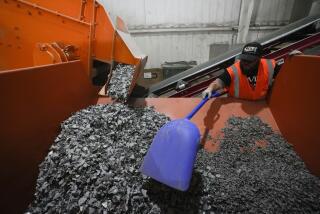Photoelectric Cells Can Plug In Remote Areas : Science: Developed by the National Renewable Energy Lab, the solar converters bring energy to places where it is too costly to run power lines.
- Share via
GOLDEN, Colo. — Deep in the heart of Brazil, special electronic cells that convert solar energy into electricity are bringing power to 600 homes.
In Africa, the cells run refrigerators to preserve badly needed vaccines.
At a Colorado ski resort, they power emergency telephones so skiers can call for help.
The source for much of this research is the U.S. government’s National Renewable Energy Lab, located 10 miles west of Denver in the foothills of the Rocky Mountains.
It was established as part of the Department of Energy in 1977 when the Arab oil embargo forced the United States to rethink its energy policies and find ways to reduce dependence on imported fuels.
Despite that mandate from Congress, however, researchers at the facility say it may take a long time to find a way to replace oil as a major source of U.S. energy.
“It’s not really our goal to replace fossil fuels, but we can greatly increase the percentage of energy provided from renewable sources,” said Patrick Summers, a spokesman for the lab.
According to a report on renewable energy issued by the national labs in March, 1990, the United States now produces 8% of its energy from renewable resources. By the year 2030, renewable energy production is expected to double, or even triple.
If 200 million acres or 25% of U.S. croplands could be converted to “energy crops” such as corn, short rotation grasses or plants, the United States could produce enough ethanol to eliminate all U.S. oil imports, researchers say. The lab is studying better ways to grow those crops.
The center also is investigating biomass electricity, hydrogen, solar and thermal energy, superconductivity, waste-water treatment and wind power.
The lab was founded 15 years ago under former President Jimmy Carter as the Solar Energy Research Institute. The goal was to develop efficient solar energy--especially photovoltaic cells, a photoelectric technology that converts solar energy directly and immediately into electricity.
The cells cost more than electric power in areas served by power lines. But in rural areas where it is too expensive to run power lines, photovoltaic technology can often save money.
Under Carter, the budget reached $124 million. When President Ronald Reagan came along, spending was cut in half.
Ironically, it was oilman George Bush who, as President, rescued the facility, expanded its mission to include other renewable energy sources, and increased funding to $167 million for this year.
Bush changed the name and mandate of the lab to include other renewable energy sources, and gave it the prestigious status of being one of 10 national laboratories in the United States.
It employs more than 600 full-time workers.
Summers said several things led to a different attitude toward renewable energy by Bush and others in the United States.
“There were the environmental concerns of the greenhouse effect and global warming, and there were also concerns raised by conflicts in the Middle East, and our energy dependence based on an unstable part of the world,” he said.
The lab already has produced a number of notable achievements:
* More than 400 homes in 14 villages in the state of Ceara, Brazil, are being wired for electric light, refrigeration and educational television for schools, along with 200 homes in Pernambuco as part of a joint effort.
* A spectroscopic scanning tunneling microscope earned NREL a 1989 award for one of the world’s 100 most-significant inventions. The microscope allows physicists to study and even alter atomic structures.
* The Department of Energy is spending $150 million over the next five years to develop hybrid propulsion systems, such as compressed natural gas and photoelectric power for cars.
* The lab has developed several methods of solar detoxification, using sunlight to help purify polluted water.
Despite more than $1.2 billion spent by the government over the last 15 years at NREL, however, Summers said it’s difficult to get businesses to join the research effort.
“There are certain high risks in areas of research, and industry doesn’t have the money to do this,” Summers said. “If government can get things started, then we can turn them over to industry with a much greater chance of saving energy resources.”
John Phillips, president of Remote Power Inc. in Ft. Collins, Colo., said his solar energy company has had extensive dealings with NREL, some good and some bad. The company has sold solar-cell equipment in Yemen, Cameroon, the Bahamas, Central America and extensively in the Western United States.
Phillips said a lot of renewable energies, especially solar power, have been mismarketed, but NREL has decided to work with companies to change attitudes.
Phillips has found his biggest market selling power units to ranchers for their wells, and, ironically, to oil producers to help them power computers at remote sites.
“They say solar power isn’t effective where there’s a power grid, but three-fourths of the world’s population is off the electric power grid,” Phillips said.
“We haven’t learned how to tap into those markets. The problem with our industry is not that it’s too expensive; the problem is that people in our industry never went after the right customers.
“There now is an enormous push for conservation technologies at NREL, and I think they are redefining themselves in good ways. I don’t know what will come of it, but at least I think they’re listening.”






